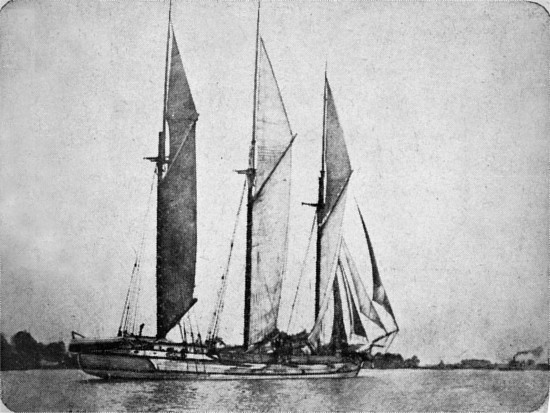Straw That Bent the Camel's Back
Toronto Telegram, 29 Oct 1949
Schooner Days CMXXIII (923)
By C.H.J Snider
THERE was no plimsoll mark on the lake schooner, and those in the lumber trade were often grossly overloaded, simply because from the nature of their cargoes they could not sink. They could, however, break up and founder, and they could leak so badly that they would lose their stability and roll over like a barrel.

The necessity for continuous pumping added to the misery of some crews. Old "Nosey" O'Brien told of his tribulations sailing the little Jessie McDonald, owned by "a widow woman in Thornhill" in the 1880's. The widow could not afford to spend any money on the Jessie, and she leaked like fury in her topsides, with the strain of her deckloads. Yet lumber was the only cargo she could be trusted to stay afloat with.
So Tommy, with two sailors—all she could afford—would try to get a hundred thousand feet board measure into and on to her at the North and Northwestern docks on the old Toronto waterfront at the west end of the Esplanade, and start for Oswego. Tommy would have to steer all the way sometimes, a hundred and fifty miles, for the two men would be kept busy handling the sails, cooking and pumping. She needed a hundred strokes an hour as a regular thing, when she was loaded, more if there was any sea on. Sometimes they made the run to Oswego in a day, sometimes in a week. There was no rest until she was unloaded and the leaking topsides were above the water level. All this and heaven, no, the other place, too, for $60 a round trip at best. It did not leave much for the widow—or anybody.
When Capt. Dan Rooney of Cobourg, "Little Dan," shipped with Uncle Hugh as cook in the Mary Taylor they piled the lumber on her so high in the gangways and over the cabintop that they could hear the poor thing groan as her back broke—or was strained—under the stress. But the pumps were all right, so they cast off from the Cobourg lumber wharves, and floated away for Oswego with a fair wind and smooth sea.
After a while the man at the wheel, buried in a doghole with the piled lumber higher than his head, sang out that she either wouldn't hold her course or the compass had gone wrong. Uncle Dan, the other uncle, said she would steer all right if he just put his mind to it, but the man answered that it took more than mind, that a donkey engine couldn't turn the wheel, and if it did it would break it off before it budged the rudder.
So they investigated, and found that she had settled down so much under the load that her transom was sitting on the head of her rudder, and the rudder stock was seized in its casing. Besides that, she was leaking now through dried-out seams being submerged, and butts beginning to gape.
They tried to repile enough of the lumber from aft to forward to let her stern spring up, but it didn't work; sometimes the rudder would move, but it didn't control her, because she was too deep by the head now, so she zigzagged and circled all over the lake. But as the wind was fair for Oswego she was slowly circling in that direction.
Other vessels were in company at the time, but they wouldn't give any assistance, taking the comfortable attitude that if the Rooneys chose to overload their vessel it was up to them. The lake was wide, and they could throw the overplus overboard, and when they were willing to pay salvage it would be time to pay attention to them.
This, however, the hardworking family would not do, for it would mean a big loss, and they grimly clung to their task until on the third day they were near enough to Oswego for a tug to tow them in, waterlogged and unmanageable and worn out, and dreading that at any moment the watersoaked pine in the hold would swell so much that her sides would burst or her deck lift off.
She was so deep in the water that they couldn't get her to the Oswego drydock, and they had to turn to and unload her by themselves, for the Oswego lumber shovers would not touch her out of her turn, and were very cagey about allowing sailors to interfere with their preserves.
They got her lightened until she stopped leaking, but she was flattened out like a pancake, and her stern was still sitting on her rudder. Enough of this was whittled away to make her steer, and they got her home—alive. But that was the end of her as the Mary Taylor.
They had to rebuild her, spending a couple of thousand dollars to make good the strains of an extra load which would not have yielded $50 extra profit at the best.
But it was not all loss. "Little Dan" learned a valuable lesson early in his career, and the repairs gave the vessel a new lease of life. She was sixteen years old when this happened, and she lived another sixteen years as a schooner, being burned in 1897, but surviving as a towbarge for five or six years, out of Kingston. Her second name was the Loretta Rooney, after a dear lady still living in Toronto, although she was only a little girl when all this happened.
